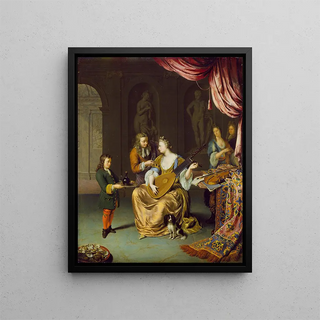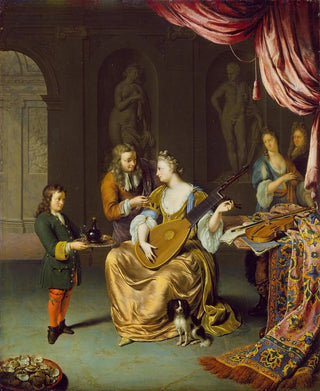Art print | The lute player - Willem van Mieris


View from behind

Frame (optional)
In the fascinating world of 17th-century Dutch painting, the art print "Le joueur de luth" by Willem van Mieris stands out for its elegance and narrative richness. This piece, capturing an intimate and poetic moment, transports us to a bourgeois salon where music and contemplation intertwine. The scene invites us to discover a young man absorbed in his instrument, the lute, while a young woman beside him appears suspended in a moment of grace. This image, both simple and complex, evokes universal and timeless emotions, while revealing the subtleties of an era when art and daily life harmoniously intertwined.
Style and uniqueness of the work
The art print by Willem van Mieris is characterized by a refined and meticulous style, typical of the Dutch school. The play of light and shadow, as well as the delicacy of the details, are essential elements that give "Le joueur de luth" an intimate atmosphere. The textures of the clothing, the shine of the lute, and the softness of the faces are rendered with remarkable precision, demonstrating the artist's exceptional talent. The composition, balanced and harmonious, guides the viewer's eye through the scene, creating a subtle dialogue between the characters. This art print does not merely depict a frozen moment in time; it also evokes the silent melody emanating from the scene, inviting everyone to imagine the music that could fill the space.
The artist and his influence
Willem van Mieris, born in 1662 in Leiden, is a prominent representative of the Dutch style of the 17th century, often associated with the tradition of genre painting. Son of the artist Frans van Mieris, he developed a style that is uniquely his own, while drawing inspiration from his contemporaries. His ability to capture moments of everyday life, with particular attention to details and the psychology of the characters, marked his era. Van Mieris also influenced many artists, notably through his approach to light and color. His works, though less well-known than those of masters like Vermeer or Rembrandt, continue to be appreciated for their finesse and depth.

Matte finish

View from behind

Frame (optional)
In the fascinating world of 17th-century Dutch painting, the art print "Le joueur de luth" by Willem van Mieris stands out for its elegance and narrative richness. This piece, capturing an intimate and poetic moment, transports us to a bourgeois salon where music and contemplation intertwine. The scene invites us to discover a young man absorbed in his instrument, the lute, while a young woman beside him appears suspended in a moment of grace. This image, both simple and complex, evokes universal and timeless emotions, while revealing the subtleties of an era when art and daily life harmoniously intertwined.
Style and uniqueness of the work
The art print by Willem van Mieris is characterized by a refined and meticulous style, typical of the Dutch school. The play of light and shadow, as well as the delicacy of the details, are essential elements that give "Le joueur de luth" an intimate atmosphere. The textures of the clothing, the shine of the lute, and the softness of the faces are rendered with remarkable precision, demonstrating the artist's exceptional talent. The composition, balanced and harmonious, guides the viewer's eye through the scene, creating a subtle dialogue between the characters. This art print does not merely depict a frozen moment in time; it also evokes the silent melody emanating from the scene, inviting everyone to imagine the music that could fill the space.
The artist and his influence
Willem van Mieris, born in 1662 in Leiden, is a prominent representative of the Dutch style of the 17th century, often associated with the tradition of genre painting. Son of the artist Frans van Mieris, he developed a style that is uniquely his own, while drawing inspiration from his contemporaries. His ability to capture moments of everyday life, with particular attention to details and the psychology of the characters, marked his era. Van Mieris also influenced many artists, notably through his approach to light and color. His works, though less well-known than those of masters like Vermeer or Rembrandt, continue to be appreciated for their finesse and depth.






